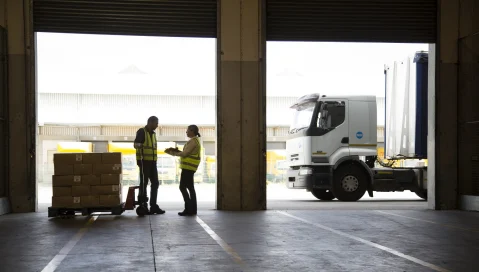How to Conquer Logistics Challenges in 2022 with Vehicle Route Planning Software
How to Conquer Logistics Challenges in 2022 with Vehicle Route Planning Software
How to Conquer Logistics Challenges in 2022 with Vehicle Route Planning Software
2 Dec 2021
Jim Endres
The current global supply chain is broken. Most people immediately blame the pandemic for the current issues, but the fact is that the pandemic simply revealed the weaknesses that already existed. While it’s true that the initial wave of the pandemic caused shortages due to global shutdowns of factories, that was just one piece of the puzzle. The supply chain is an ecosystem; and a variety of factors have caused the breakdown.
Once workers returned to the factories and warehouses, some were forced to shut down again due to outbreaks in certain nations. Even those companies that were operating at full capacity had to deal with computer chip shortages, massive port congestion, and a nationwide shortage of truck drivers. This means that the world's supply chains are in a nightmarish bottleneck exacerbated by the pandemic.
For companies that operate with smaller inventories and use the “just in time” methodology to fulfill their orders, these issues are multiplied. Then they must rush to order extra inventory, which further aggravates the strain on the supply chain. In addition, new variants of the pandemic have made it harder for trucks to cross borders. West Coast ports in the U.S. were already struggling with the explosion in freight, and the truck shortage means that there are less people to take containers to their destinations. The containers piled up on the docks, and ships spent weeks at port waiting to unload.
So how can logistics companies survive in this new era?
Meeting the logistics challenges of 2022 requires a new way of looking at the supply chain. It is not a linear entity; instead, it is an interconnected system that demands enhanced visibility, reliable analytics and communication to grow. The solution? Digitalization of logistics. Truck route planning software can help logistics managers meet the greatest supply-chain challenges—now, and in the future.
Addressing Supply-Chain Challenges With Route Planning Software
Driver Shortages
It’s no secret that we are facing a global shortage of qualified truck drivers. The U.S. reports a shortage of some 80,000 drivers. Part of it is that many older drivers have reached retirement age, and younger generations are not flocking to the profession. Other analysts state that higher federal unemployment benefits, which just ended in September of 2021, made many drivers disinclined to return to work. With competition coming from transportation start-ups hungry for market share, it’s difficult to retain staff. Driver turnover is high—studies showed that larger firms in particular saw more than 90% turnover in late 2020.
How can transportation companies retain the drivers they have? The answer is simple. Routing and scheduling software.
Routing and scheduling software takes the guesswork out of route planning. Your drivers don’t have to spend hours doing paperwork or worrying about Hours of Service (HoS) compliance. Instead, the software assigns routes with HoS data already factored in. Drivers and dispatchers will know that their daily work schedules and routes have been optimized and are well within legal limits. This means that the drivers can increase their earnings because they will maximize their working hours.
No more missed appointments or spending hours at a location waiting for the loading dock to be ready. The software factors in whatever constraints you require, such as the opening and closing times of loading and unloading facilities. If a driver reports that they must always wait to unload at a particular facility, your service team can communicate with that customer and ascertain a better time for delivery. This ensures that the software creates routes so that your drivers are at the right place at the correct time.
If an incident should occur, the software also aids the dispatch team in guiding the drivers to the best routes. This allows your drivers to focus on their deliveries, not on service issues.
The software also considers the personal needs of drivers. A driver can select a favorite vehicle, a favorite shift, and PTO and leaves of absence are automatically input into the schedule. Routing software also helps with driver retention. Drivers often leave because of what they perceive as unfair route allocations. A route optimization solution eliminates that because it plans routes without bias.
You can also use the vehicle telematics to keep track of route metrics. The software’s reporting and analytics feature allows fleet managers to keep track of crucial KPIs. They can then put a substantial incentive program in place. For instance, offer a monthly cash bonus to the driver who makes the most stops on time. Truck route planning software makes it easier for your drivers to succeed—which makes it easier for you to keep them happy.
Rising Costs of Transport Operations
Did you know that the savings for a company using fleet route planning software ranges between 10% and 30%? It does this by optimizing use of your drivers and vehicles. The software uses computer algorithms that calculate the most achievable and efficient routes. Your drivers can complete the maximum number of deliveries on time, with fewer miles driven. This leads to less wear-and-tear on vehicles, and fuel savings.
So how does it work? Route optimization software creates schedules which result in reduced miles and time driven to complete deliveries. Therefore, less fuel is consumed. The system creates delivery schedules based on a number of factors. Then, the software produces efficient plans that account for all operational constraints, like specified delivery windows, vehicle capacity, and driver Hours of Service. Once all this information has been entered, the software finds the most cost-effective routes.
Now, your fleet is travelling fewer miles and the number of deliveries per route has increased. You may find that you will need fewer vehicles. That’s a simple cost saving right there. Plus, costs for maintenance and replacement vehicles are reduced as mileage goes down.
Digitizing your routing enables you to offer your customers complete visibility into their delivery. They get accurate planned arrival times and regular ETA updates as the day progresses. This leads to reduced inbound call volumes and higher customer retention rates, all of which contributes to your bottom line.
Maintaining a Sustainable Operation
Sustainable transport practices, such as route optimization and reducing half-full trucks, are more efficient and often more profitable. While today’s consumer wants faster shipping times, they also care about sustainability. Customers often make their buying decisions based on how environmentally responsible a company is.
Think about it this way—if you adopt sustainable transportation practices now, you’ll be one step ahead of new, low carbon and carbon-neutral legislation. You can thus avoid fines due to non-compliance.
You know that implementing vehicle routing and scheduling software can save you money. But did you know that it can help you run a greener fleet? Routing software helps you plan more efficient routes. This reduces fuel consumption. Your routes are planned and executed using sophisticated algorithms configured specifically for your delivery operation. This reduces route time, route miles, and saves on fuel costs—which makes your business more sustainable.
Routing software also helps reduce delays and unnecessary idling. Your route planning is more accurate, which means that you’re more precise in calculating arrival times at delivery destinations. Your customer will know, down to the minute, when to expect your drivers, so deliveries are processed faster. That means your drivers can fit more deliveries into a day, and they’ll save fuel because your trucks are not idling in line.
Making your fleet more sustainable doesn’t have to be difficult. Here’s the rub: reducing inefficiencies in truck routing means there are fewer trucks on the road. As a result, roads are less congested, so traffic gets better. Using routing software can help because if your fleet is burning less fuel, you’re reducing your carbon footprint. Simple.
It's clear then, that implementing vehicle route planning software offers a host of benefits for your logistics operation, helping you tackle your biggest challenges all while simplifying your daily processes. You're sure to have many questions to answer before getting started on your journey to supercharged route optimization. To help you get up to speed you can check out our fleet routing software FAQs or our handy guide to identifying the best route planning software.
You can also discover more about our advanced routing solution that has been at the forefront of solving the biggest challenges in the industry for over 30 years. Our industry-specific routing and scheduling software, Aptean Routing & Scheduling, maximizes fleet utilization and efficiency to reduce the number of vehicles and miles you need. At the same time, it improves customer satisfaction by helping you deliver within promised time windows; and keeps your drivers happy by creating equitable routes. By allowing you to do more with less, it can also help you meet your sustainability objectives.
Ready to discover how you can overcome your transportation challenges? Contact us to find out how, now.
Related Articles





Ready to start transforming your business?
We've got the specialized TMS solutions you need to conquer your industry challenges.



